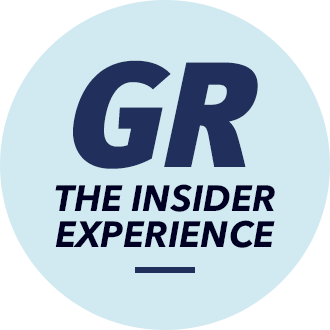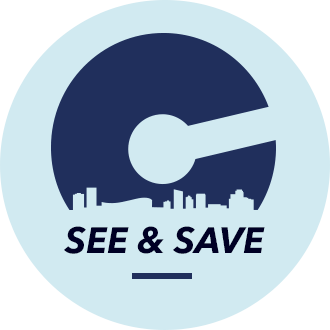When ArtPrize launched in 2009, I was skeptical. I’d never heard of anything like it (because there isn’t anything quite like it) and couldn’t conceive of the entire concept. Nonetheless, I picked up a map, planned a route, and headed downtown to check it out.
Amazed isn’t an exaggeration of how I felt. Some of the art moved me, powerfully. Other pieces fascinated me with their intricacy. The depth and scope of what the artists created, and the visionary way it was displayed throughout the city of Grand Rapids, turned me from skeptic to fan after touring my first venue. I loved casting my votes on the pubilcly-installed art. I was hooked.
I wasn’t alone. The thrill of discovering art in unexpected venues and in urban settings is exhilarating. By 2018, international art competition attracted over 500,000 visitors. This fall you’ll be able to check out ArtPrize, under new leadership, from September 14 – October 1, 2023.
Whether, like me, you’ve loved ArtPrize from day 1, or you’re new to the free art exhibition, fall isn’t the only time you can get a taste of the event year-round because many former ArtPrize pieces remain as permanent installations or parts of collections in the Grand Rapids area.
If you’re ready to get your ArtPrize fix by visiting past entries, here are five to get you started. (You can also check out this 2018 article, published by WZZM-13, which shares where you can find permanent installations, keeping in mind that the list is a few years old.)
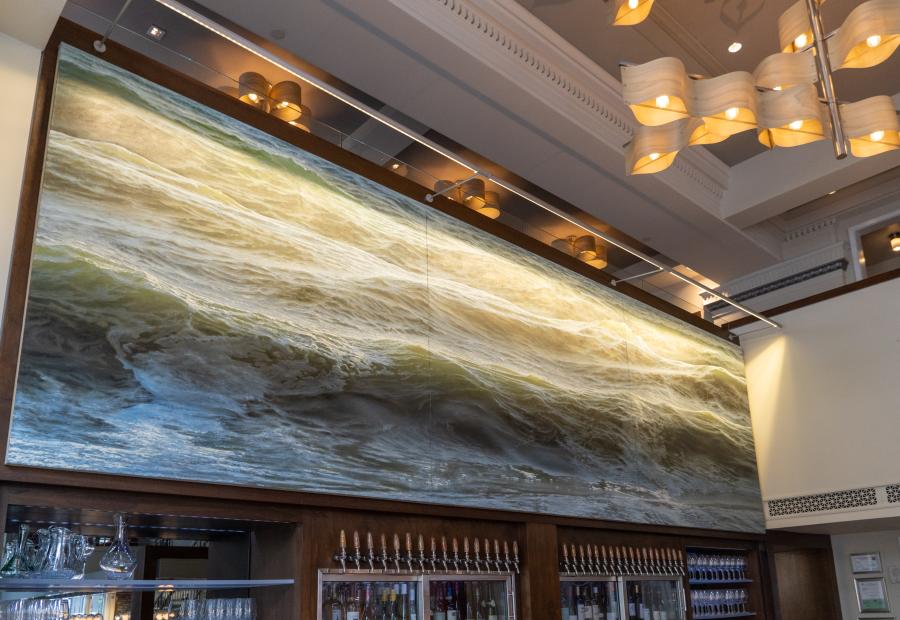
Take a look at Open Water No. 24 next time you're dining at Reserve Wine and Food.
Photo by Brian Craig for Experience Grand Rapids
Open Water No. 24
by Ran Ortner, on display at Reserve Wine and Food – ArtPrize 2009
When you visit Reserve Wine and Food, you know you’re in for a treat in terms of wine selection and outstanding food. The fact that you can also stand in front of this incredible three-panel, 6x19-foot-wide painting is a bonus. No matter how many times I see it, I feel the timeless pull and power of the ocean.
The unframed oil-on-canvas has such depth. Without the sky, land, boats, or other reference points, your focus is entirely on the magnificence and intensity of the waves.
Open Water No. 24 was originally displayed in the Old Federal Building, now a part of Kendall College of Art and Design of Ferris State University, during the very first ArtPrize (2009). Visitors responded enthusiastically to the tension and balance the piece portrays between the beauty and power of the sea.
I loved this painting from the moment I saw it and was among the voters who helped it win the competition’s top $250,000 prize. It was the only painting among ArtPrize 2009’s top 10 finalists.
“ArtPrize was a surreal experience,” says artist Ran Ortner. “Being involved in the first year there was no precedent. It was magical! It was a wonderful adventure and, for me, the most extraordinary Cinderella ending. I’ll always be grateful.

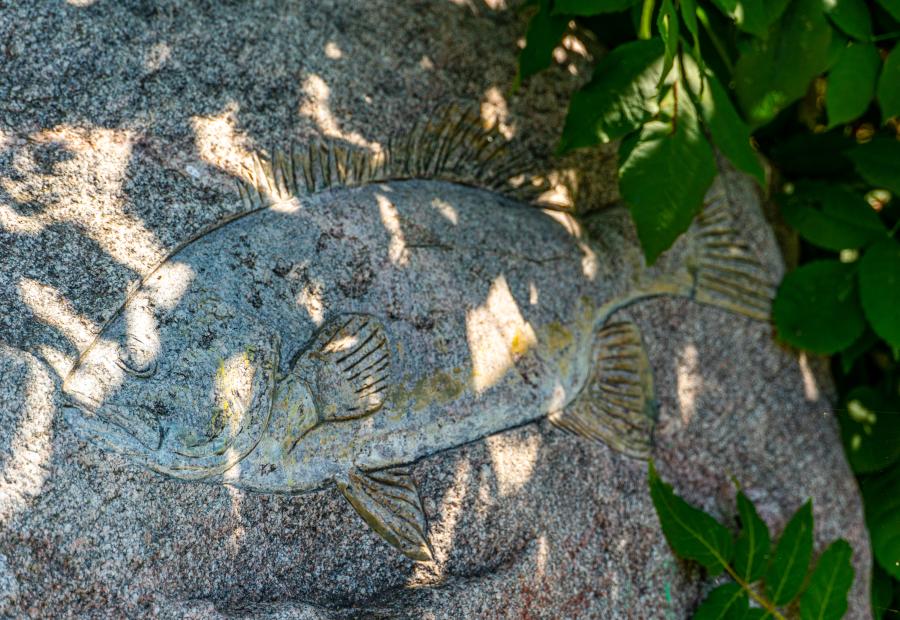
Grand River Fish Petroglyph shows fish native to the Grand River.
Photo by Brian Craig for Experience Grand Rapids
Grand River Fish Petroglyph
by Kevin Sudeith, on display outside the Grand Rapids Public Museum – ArtPrize 2014
I walked along the river by the Grand Rapids Public Museum as I attended the sixth annual ArtPrize. It was a beautiful, sunny fall day and I was immediately taken with the creativity and skill of artist Kevin Sudeith.
For his installation, he brought in five fieldstone boulders, 3,000 pounds each, and used chisels and battery-powered tools to carve images of 20 species of fish found in the adjacent section of the Grand River like sturgeon, lake trout, and Northern pike.
I loved his creativity, the way he capitalized on the natural setting, and that his work was representative of life in the river. The intricate carvings were also astonishingly detailed.
“The visual literacy and art vocabulary of people in the region around ArtPrize was impressive and well-informed,” says Sudeith. “People maintained a large mental inventory of artworks from past ArtPrizes, and they had strong opinions about artworks, artists, and winners.”
Sudeith’s ArtPrize entry was his first installation in an urban setting and was selected as one of the top five installations in ArtPrize 2014.
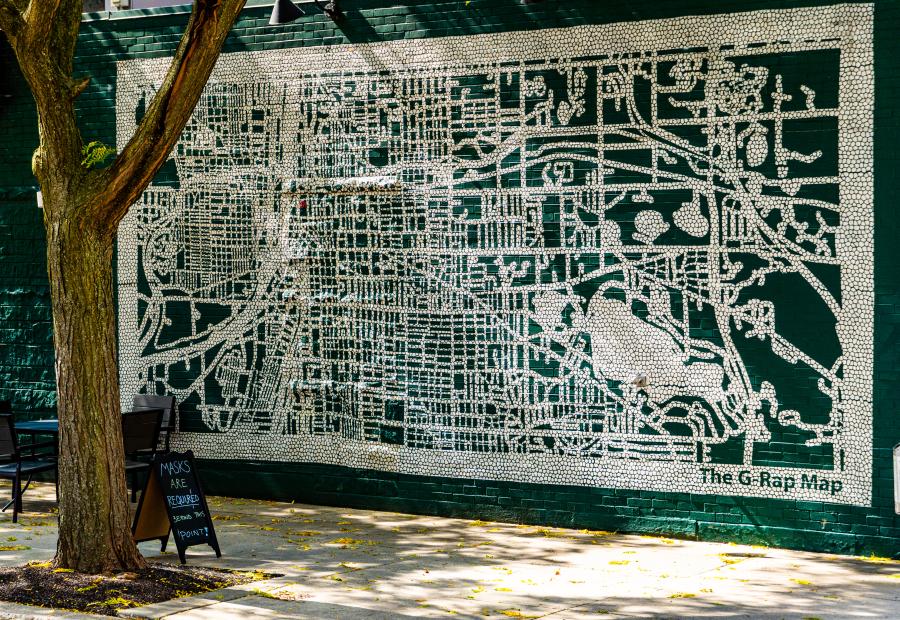
You'll find the G-Rap Map on the outside of the Apartment Lounge.
Photo by Brian Craig for Experience Grand Rapids
The G-Rap Map
by Justin Smith, located on the exterior of the Apartment Lounge – ArtPrize 2013
At first glimpse this large mural appears to be some sort of maze but, as you draw near, you can see that it’s a graphic representation of the very city in which you stand.
“I wanted to do something with maps that would match the venue, particularly an outdoor wall venue,” explains artist Justin Smith. “The paint I used is the same white paint that’s used for sidewalk crossings. It’s durable and appropriate for a street map.”
To create the mural, Smith started with the map design and then laser cut the reverse of the design into large pieces of felt. He applied the felt to the wall and then painted the map – similar to using a stencil pattern.
If you look closely, you’ll see that the street “lines” are actually small “blobs” of white paint, as Smith calls them, that, interestingly, include geometrical data that ArtPrize 2013 visitors could unlock by looking at the painted points through an app called Layar Viewer.
Through the app, the map appeared to be red and you could see icons the artist had “hidden” in the geometrical data. Unfortunately, the app using the innovative augmented reality technology is no longer available, but the impressive mural stands the test of time.
Even without the app, there are a few goodies hidden in plain sight. Look closely at the location of John Ball Zoo, for example. “I snuck a bear face on the zoo,” says Smith. You’ll also see that the Calder is painted red. “If you can find the Calder, you can orient yourself.”
Smith’s 2014 ArtPrize submission, G-Rap Map 2.0, also remains in Grand Rapids. The 8x4-foot map of the city was made of ¾ Maple wood and painted Calder red. This piece is on display in the DeVos Place Convention Center.
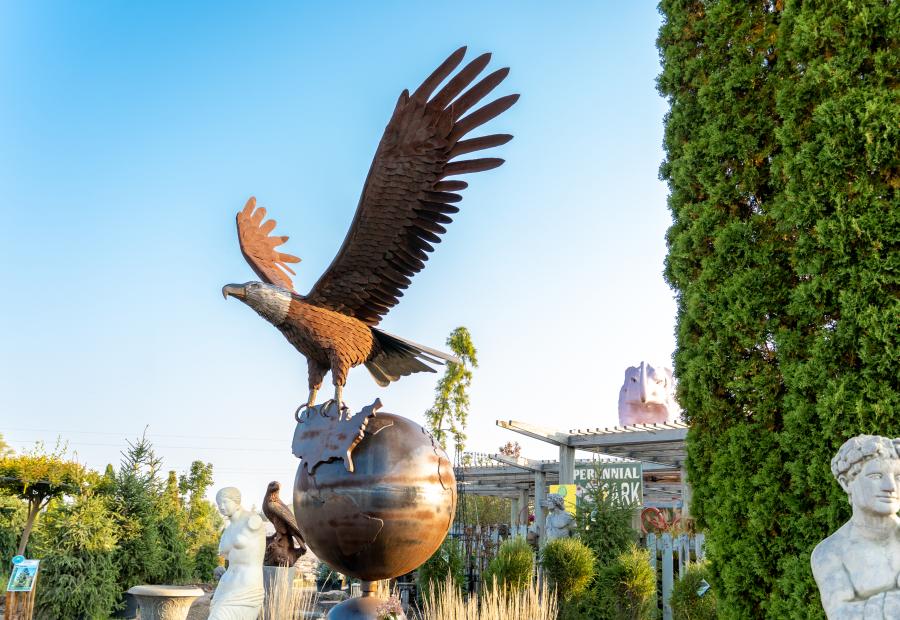
Bird of Prey is made from materials found in scrap piles and junkyards.
Photo by Brian Craig for Experience Grand Rapids
Bird of Prey
by Tom Sheerin, located at Harder and Warner Landscaping and Garden Center – ArtPrize 2013
While the inside of the B.O.B. housed many great ArtPrize pieces, the venue’s outdoor space lent itself to works of grandeur.
One such piece was Sheerin’s impressive, 14x16x7-foot Bird of Prey. He crafted the metal eagle entirely out of recycled household objects, like kitchen utensils and machetes. The end result was a regal bald eagle whose magnificent presence dominated the area. The bird appears to be in flight, aggressively in pursuit of…something!
The artist salvaged the discarded materials from scrap yards and junk piles, hoping to call attention to the abundance of accumulated goods in landfills. Concerned about the environment, Sheerin chose to create the bald eagle for his ArtPrize entry.
From 1973 – 2007, the bald eagle was on the Endangered Species list. In his description about Bird of Prey on the ArtPrize website, the artist said, “Just as the Bald Eagle has made an impressive comeback from being endangered, many other environmental successes are possible if we begin making more environmentally responsible choices.”
As you walk around the grounds of Harder and Warner, you can see four additional former ArtPrize entries: The Queen’s Silver Steed, by Douglas Gruizenga (ArtPrize 2014), Steam Baby, by Anthony Jackson (ArtPrize 2013), I Used to Be an Octopus, by Lou Rodriguez, (ArtPrize 2015), and Elephant Walk, by Frederick Prescott (ArtPrize 2010, 10th place winner), as well as a kinetic giraffe sculpture also by Frederick Prescott.
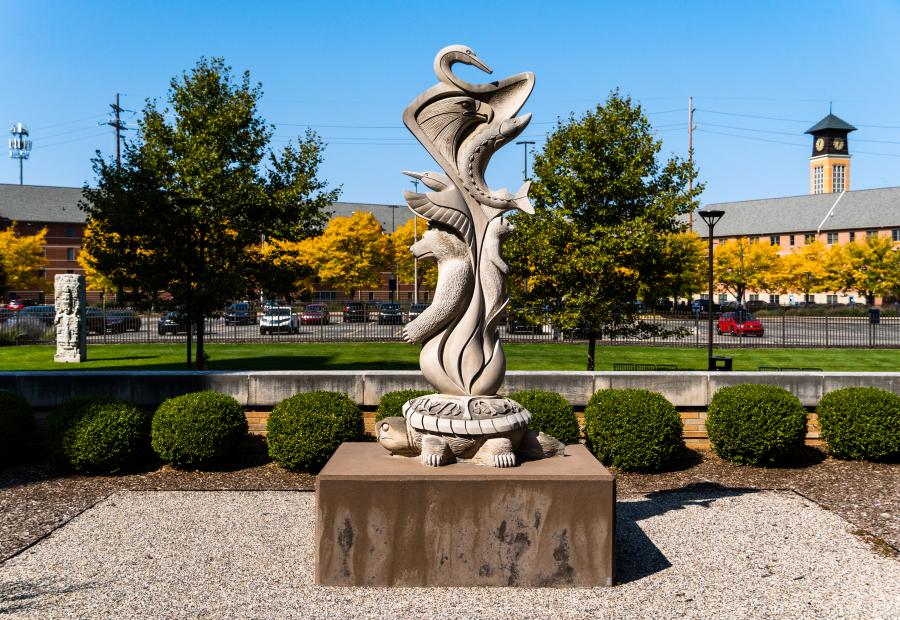
The 7 Chief Clans of the Anishinabe is located on Grand Valley State University's downtown Grand Rapids campus.
Photo by Brian Craig for Experience Grand Rapids
The 7 Chief Clans of the Anishinabe
by Jason Quigno, located at the Seidman Center, outside courtyard, GVSU Pew Grand Rapids Campus – ArtPrize 2011
Stone sculptor Jason Quigno, a member of the Saginaw Chippewa Indian Tribe of Michigan, carved a meaningful tribute out of limestone, creating a graceful sculpture of the Crane, Loon, Bear, Turtle, Martin, Fish, and Birds, the 7 Chief Clans of the Anishinabe people. The sculpture stands nearly 10-feet tall.
“I chose that sculpture to represent the people who were here before,” says Quigno. “The Grand River area was a meeting place for the natives of this area and we really didn’t have a monument to represent us. I wanted to put our stories in stone. They’ll be here for the next thousand years or more.”
For ArtPrize 2010, Quigno carved Zoondige-Kwe: Strong Hearted Woman, a depiction of a woman with flowing hair, wearing a robe. You can see it in Holland, Michigan, at 99 E. 8th Street, just east of the Norcross Warner + Judd building.
You can see yet another Quigno sculpture at the Gerald R. Ford International Airport. You’ll find it located near the baggage claim area, which you can access even if you’re not an airline passenger. Four flames, representing the four cardinal directions, sit on a black granite turtle. “It twirls up like a whirlwind to represent smoke, which represents our prayers and our intentions going up,” explains Quigno. “At the top are four eagles, representing the eagle carrying our prayers to the Creator.” The sculpture is almost 10 feet high.
Bonus: Cavalry - American Officers, 1921
by Chris LaPorte, located at Grace Hauenstein Library at Aquinas College
When Aquinas College Associate Professor of Art, Chris LaPorte’s gorgeously-detailed pencil sketch of military men won first prize in ArtPrize 2010, the college acquired the piece as part of a long-term loan. The poignant 28 x 9-foot drawing, which took LaPorte more than 800 hours to complete, is based on a photograph the artist saw in a Grand Rapids’ antique shop. You can see the work of art in the lobby in the Jarecki Lacks Hauenstein (JLH) building at Aquinas, just outside of the Grace Hauenstein Library. The library and building are generally open to the public Monday - Thursday, 8AM - 9PM, Friday 8AM - 5PM and Sunday 12PM - 9PM during the academic school year. Hours are posted on the front doors and change during holidays and breaks, including the summer.
Mark your calendar for the world’s most attended public art event.

